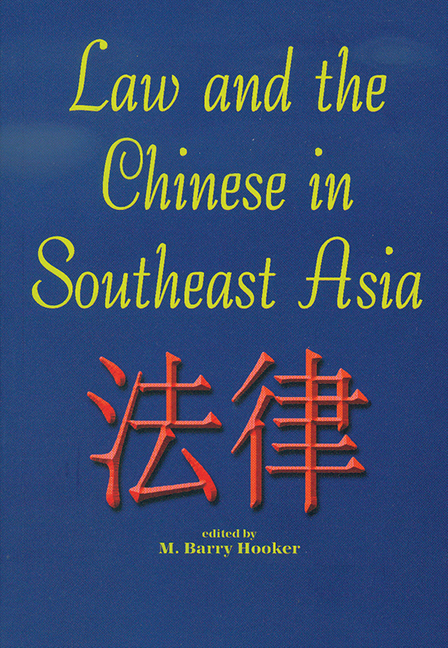Book contents
- Frontmatter
- Contents
- Preface
- The Contributors
- 1 Law and the Chinese Outside China: A Preliminary Survey of the Issues and the Literature
- 2 The Legal Position of the Ethnic Chinese in Indochina under French Rule
- 3 Law and Memory, De Jure to De Facto: Confucianization and its Implications for Family and Property in Vietnam
- 4 English Law and the Invention of Chinese Personal Law in Singapore and Malaysia
- 5 The Indonesian Chinese: “Foreign Orientals”, Netherlands Subjects, and Indonesian Citizens
- 6 Chinese Family Firms in Indonesia and the Question of “Confucian Corporatism”
- 7 China's Citizenship Law and the Chinese in Southeast Asia
- Index
7 - China's Citizenship Law and the Chinese in Southeast Asia
Published online by Cambridge University Press: 21 October 2015
- Frontmatter
- Contents
- Preface
- The Contributors
- 1 Law and the Chinese Outside China: A Preliminary Survey of the Issues and the Literature
- 2 The Legal Position of the Ethnic Chinese in Indochina under French Rule
- 3 Law and Memory, De Jure to De Facto: Confucianization and its Implications for Family and Property in Vietnam
- 4 English Law and the Invention of Chinese Personal Law in Singapore and Malaysia
- 5 The Indonesian Chinese: “Foreign Orientals”, Netherlands Subjects, and Indonesian Citizens
- 6 Chinese Family Firms in Indonesia and the Question of “Confucian Corporatism”
- 7 China's Citizenship Law and the Chinese in Southeast Asia
- Index
Summary
This chapter deals with China's citizenship law and the Chinese in Southeast Asia during three periods, namely, the Qing (Ching) Dynasty, the Republican period, and the People's Republic (PRC) period. It examines the contents of these laws, why they came into being, how they were implemented, and what their impact was on the ethnic Chinese in Southeast Asia. The main emphasis will be on recent developments, that is, after the emergence of the PRC.
There are approximately 23 million Chinese in Southeast Asia, forming the largest Chinese community — about 80 per cent — outside China. Of the ten Southeast Asian countries, the Chinese in Indonesia are the largest in absolute numbers (about 6.2 million), followed by Malaysia (about 5.5 million), Thailand (about 5.2 million). The smallest number is in Laos (about 10,000). In terms of percentage of the Chinese to the non-Chinese population, however, Singapore has the highest (about 77 per cent), followed by Malaysia (24.8 per cent) and Brunei (16 per cent). The lowest is still Laos (0.4 per cent).
The majority of the Chinese who came to Southeast Asia before Western expansion was mainly Huashang (Chinese traders), and their number was relatively small. Only after Western colonization, because of the pull and push factors in China and Southeast Asia, did a large number of the Chinese arrive in the region — many were Huagong (Chinese coolies). Of course, there were also traders but they formed a minority.
Although many Chinese in Southeast Asia were coolies, the most significant among them with regard to law was the commercial group. Thus, the Chinese came to be known as the “trading minority of Southeast Asia”. As time passed, the Chinese formed the middle class in their adopted countries — in Thailand, they even became both the economic and political élite.
In colonial Southeast Asia, the national status of the Chinese was not an issue until the nineteenth century when the Western powers imported Chinese coolies, and the Chinese overseas became politically important in the politics of mainland China. The ethnic Chinese were the source of both political and economic support. Not surprisingly, there was a tussle between the Western colonial powers and Qing China over control of the Chinese through the “nationality (citizenship) law.”
- Type
- Chapter
- Information
- Law and the Chinese in Southeast Asia , pp. 169 - 202Publisher: ISEAS–Yusof Ishak InstitutePrint publication year: 2002



